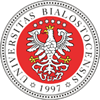Proszę używać tego identyfikatora do cytowań lub wstaw link do tej pozycji:
http://hdl.handle.net/11320/5390| Tytuł: | Baśń = Das Märchen |
| Inne tytuły: | Fairy Tale |
| Autorzy: | Goethe, Johann Wolfgang von |
| Redaktor(rzy): | Kunicki, Wojciech Ławski, Jarosław |
| Tłumacz: | Krzemień-Ojak, Krystyna |
| Słowa kluczowe: | Goethe Baśń Czarny Romantyzm |
| Data wydania: | 2017 |
| Data dodania: | 11-kwi-2017 |
| Wydawca: | Katedra Badań Filologicznych „Wschód – Zachód” Wydział Filologiczny Uniwersytetu w Białymstoku; Wydawnictwo Alter Studio |
| Seria: | Czarny Romantyzm; |
| Abstrakt: | Wir präsentieren heute die erste polnische kritische Ausgabe von Das Märchen von Johann Wolfgang von Goethe (1749-1832) in der wissenschaftlichen Verlagsserie „Die Schwarze Romantik”. Das im Jahre 1795 entstandene und in demselben Jahr von Friedrich Schiller in der Zeitschrift „Die Horen” herausgegebene Werk gehört zu den am meisten in der Welt kommentierten und interpretierten Werken Goethes. Es steht in diesem Ausmaß nur dem Faust nach. In Polen fand es bisher keinen so breiten Wiederhall. Zwar wurde es im Jahre 2000 durch den Verlag Arche in der Übersetzung von Marek Sołek herausgegeben, aber diese Edition schrieb gleichzeitig Das Märchen Goethes der anthrosopischen Strömung von Rudolf Steiner (1861–1925) zu. Dieser – übrigens nicht als erster - hatte das Werk im Geiste seiner eigenen Gedanken als äußerst mehrdeutig, hermetisch, symbolisch interpretiert. Vielleicht liegt der Grund für die geringe Kenntnis und Popularität Des Märchens in Polen am generell schwachen Anklang des deutschen Märchens an der Wende des 18. zum 19. Jahrhundert in dem Land, das gerade ein Trauma nach der Teilung erlebte. Wir fügen hier hinzu, dass Das Märchen im Jahr der dritten Teilung der Republik Polen erschien. Sein Ursprung hängt mit Folgen der Französischen Revolution für Deutschland zusammen. Es beendet nämlich die Prosazyklen der Unterhaltungen deutscher Ausgewanderten von Goethe. Die vorliegende Edition bringt die neue, aber eigentlich die erste kritische Übertragung Des Märchens [der vollständige Titel lautet: Das Märchen von der grünen Schlange und der schönen Lilie] und stammt von der herausragenden Übersetzerin deutscher Literatur, Frau Dr. Krystyna Krzemień-Ojak. Professor Wojciech Kunicki, Germanist der Universität zu Breslau, hat sie mit einem Vorwort versehen. Es ist zugleich eine zweisprachige Auflage, die eine Chance für einen direkten Vergleich des Originals des semantisch komponierten Werkes mit der hier vorgelegten Übersetzung bietet. Diese Veröffentlichung Des Märchens geht mit der pararellen Herausgabe eines Werkes der deutschen philosophischen Literatur aus der Romantik einher, nämlich mit den Ansichten von der Nachtseite der Naturwissenschaft (Dresden 1808) von Gotthilf Heinrich Schubert (1780–1860). Es bezieht sich direkt auf Goethe. Die Edition Des Märchens war dank der großzügigen finanziellen Unterstützung der Stiftung für Deutsch–Polnische Zusammenarbeit möglich. Das Märchen ist ein Werk mit einer besonders komplizierten Semantik: „Man kann sie als eine Allegorie der Zeit der Französischen Revolution lesen oder als ein Werk, das ein Spiel des Vorstellungsvermögens ist. Rudolf Steiner sah darin eine Illustration der eigenen Anthrosophie und schrieb, dass dieses Werk in märchenhaften Bildern die Entwicklung der menschlichen Seele vor dem geistigen Blick Goethes schildert, von dem Gefühl des Fremdseins gegenüber der geistigen Welt bis hin zu den Höhepunkten des Bewusstseins im erfüllten Leben durchdringt, sodass beides eins wird. Er äußert sich dazu ergänzend, dass Goethe diesen Prozess der Verwandlung der Seele nur in leicht skizzierten Gestalten der Fantasie zeigte”. Prof. Wojciech Kunicki ist hingegen der Meinung, dass man dieses Werk im Bedeutungsrahmen des Zyklus lesen sollte, zu dem es gehört: „(...) Man liest den Text Des Märchens verhältnismäßig selten in dem richtigen Kontext, d.h. als Abschluss des Zyklus der Unterhaltungen deutscher Ausgewanderten. Die Interpretationen, die diese beiden Texte trennen, sowie leider auch die Praxis der Verlage, verursachten die Geringschätzung der Unterhaltungen als einen unselbstständigen (sekundären) Textkorpus und die interpretatorische Aufwertung Des Märchens als ein Fantasiegebilde mit allegorischen und symbolischen Bedeutungen”. Unabhängig von der angenommenen interpretatorischen Richtung sollte man dem Postulat zustimmen, dass die Präsenz des Werkes von Goethe in der Reflexion über polnische und deutsche Literatur am Ende des 18. Jahrhunderts und in der 1. Hälfte des 19. Jahrhunderts stärker betont werden sollte. Das Werk sollte auch im komparatistischen Kontext Beachtung finden. The Scholarly Publishing Series ‘Dark Romanticism’ presents the first Polish critical edition of Fairy Tale by Johann Wolfgang Goethe (1749–1832). Written in 1795 and published in the same year in Friedrich Schiller’s magazine Die Horen, it is one of the most often commented and interpreted works of Goethe (with the obvious exception of Faust). In Poland it has not received a considerable attention of critics and readers. The Publishing House ‘Arche’ published Marek Sołek’s translation of Fairy Tale in 2000; however, this edition located Goethe’s tale in the anthroposophy of Rudolf Steiner (1861–1925), who interpreted this exceptionally ambiguous, hermetic and symbolic text in his own, biased way. In the more distant past, the poor reception and lack of popularity of the German tale written at the turn of the 18th century may have resulted from the post-partition trauma prevailing in Poland. Fairy Tale was published in the year of the Third Partition of Poland, and the origin of the text is linked with the ramifications of the French Revolution for the Germans. The tale rounds up Goethe’s prose series Unterhaltungen deutscher Ausgewanderten. The present volume brings a new – in fact, the first critical – rendition of Das Märchen [the full title: The Green Snake and the Beautiful Lily] by the notable translator of German literature Krystyna Krzemień -Ojak, PhD, with an introduction by Professor Wojciech Kunicki, the University of Wrocław. The bilingual edition gives the reader an opportunity to compare the original, semantically complicated text with the proposed Polish translation. At the same time, the present editorial project is accompanied by the publication of the important philosophical work of German romanticism, Ansichten von der Nachseite der Naturwissenschaft (Dresden 1808) by Gotthilf Heinrich Schubert (1780–1860), which Goethe directly refers to in his tale. The publication of Fairy Tale was possible thanks to the generous support of the Foundation for Polish–German Cooperation (Stiftung für Deutsch-Polnische Zusammenarbeit). Goethe’s work is informed by an exceptionally complex semantics – it can be read as an allegory of the times of the French Revolution or the figment of pure imagination. Rudolf Steiner saw in it the illustration of his anthroposophy: “In the fairytale images of this work, Goethe envisions the development of the human soul estranged from the spiritual world. The feeling reaches the level of consciousness on which the sensual life merges with the supra-sensual life, becoming one. Goethe saw this process of change in delicately sketched forms of fantasy”. Professor Wojciech Kunicki, in turn, proposes to interpret the tale in the framework of the cycle of stories to which it belongs: “Critics do not often read Fairy Tale in its proper context, i.e. as the final part of Unterhaltungen deutscher Ausgewanderten [Conversations of German Emigrants]. Interpretations that tended to treat these texts separately and, regrettably, the analogical decisions of publishers have resulted in the undervaluation of Unterhaltungen as a dependent (secondary) corpus of texts and in the overvaluation of Fairy Tale as the product of imagination, generating allegorical and symbolic meanings”. However, regardless of the interpretive perspective, it is commonly agreed that various readings of Goethe’s text need to be an integral part of our reflection on Polish and German literature at the turn of the 18th century – the reflection that should encompass comparative studies. |
| Nota biograficzna: | KRYSTYNA KRZEMIEŃ-OJAK, (1932–2016), tłumaczka, polonistka i germanistka; studia polonistyczne odbyła w latach 1950–55, studia germanistyczne w latach 1964–68 na Uniwersytecie Warszawskim; obroniła doktorat w Instytucie Badań Literackich PAN w 1972 roku, napisany pod kierunkiem prof. Marii Żmigrodzkiej. Autorka książki: Maurycy Mochnacki. Program kulturalny i myśl krytycznoliteracka (Warszawa 1975). Obszerny dorobek przekładowy, przeważnie klasycznych i współczesnych tekstów filozoficznych z obszaru języka niemieckiego: Ludwiga Feuerbacha (Wybór pism, t. I-II), Theodora Adorno (Dialektyka negatywna, Sztuka i sztuki. Wybór esejów, Teoria estetyczna), Friedricha Wilhelma Josepha Schellinga (System idealizmu transcendentalnego, Filozofia sztuki, Filozofia Objawienia. Ujęcie pierwotne), Fryderyka Nietzschego (Wybór tekstów), Alberta Schweitzera (Wybór tekstów), Waltera Benjamina (Dzieło sztuki w epoce możliwości jego technicznej reprodukcji, W sprawie krytyki przemocy), Hansa Georga Gadamera (Aktualność piękna. Sztuka jako gra, symbol i święto), Karla Jaspersa (Trzeci wykład: Człowiek), György Lukacsa (Sztuka i prawda obiektywna), Carla Gustawa Junga (Psychologia i twórczość), Maxa Horkheimera (Uwagi na temat antropologii filozoficznej), Jürgena Habermasa (Od wrażenia zmysłowego do symbolicznego wyrazu), książek Odo Marquarda (Rozstanie z filozofią pierwszych zasad, Apologia przypadkowości, Szczęście w nieszczęściu. Rozważania filozoficzne) i Herberta Schnädelbacha (Filozofia w Niemczech 1831–1933, Rozum i historia. Odczyty i rozprawy 1., Próba rehabilitacji „animal rationale”. Odczyty i rozprawy 2.); tłumaczyła również prace filozoficzne Steffena Dietzscha – książkę: Krótka historia kłamstwa. Przekorne eseje filozoficzne (Warszawa 2000), Immanuel Kant. Biografia (2005), Życie w labiryntach. Motyw labiryntu w filozofii kultury po Nietzschem (2012). Tłumaczka Straży nocnych Bonawentury (A. E. F. Klingemanna) na język polski. WOJCIECH KUNICKI, (ur. 1955 w Kaliszu), prof. zw., polonista, germanista, tłumacz. Zajmuje się twórczością Ernsta oraz Friedricha Georga Jüngerów i tłumaczy ich książki. Wydał, przeważnie w Niemczech, szereg publikacji dotyczących Śląska (Seria „Schlesische Grenz- gänger”, 5 t., Seria Deutsch-Polnischer Kulturtransfer, 5 t., seria Biblioteka Ślężańska, 6 t.). Ostatnio zrealizował międzynarodowy projekt NCN poświęcony dziejom germanistyki polskiej, 3 tomy ukażą się w RFN, tom IV, poświęcony inwigilacji środowisk germanistycznych przez SB, w Polsce (IPN). Jest pracownikiem naukowo-dydaktycznym Instytutu Fiologii Germańskiej we Wrocławiu. JAROSŁAW ŁAWSKI, (ur. 1968 w Szczytnie), prof. zw., badacz wyobraźni literackiej i polsko-wschodnioeuropejskich relacji kulturowych, twórca Katedry Badań Filologicznych „Wschód – Zachód” na Uniwersytecie w Białymstoku. Zainteresowania: literatura polska i powszechna od XVIII do XXI wieku, przemiany wyobraźni, faustyzm i bizantynizm w literaturze, romantyzm, modernizm, poezja Czesława Miłosza. Redaktor naczelny Naukowych Serii Wydawniczych „Czarny Romantyzm”, „Przełomy/Pogranicza”, „Colloquia Orientalia Bialostocensia”. Napisał m.in.: Wyobraźnia lucyferyczna. Szkice o poemacie Tadeusza Micińskiego „Niedokonany. Kuszenie Chrystusa Pana na pustyni” (1995), Ironia i mistyka. Doświadczenia graniczne wyobraźni poetyckiej Juliusza Słowackiego (2005), a także Mickiewicz – Mit – Historia. Studia (2010), Miłosz: „Kroniki” istnienia. Sylwy (2014). Współredaktor tomów: Postacie i motywy faustyczne w literaturze polskiej (t. I-II, 1999, 2001), Pogranicza, cezury, zmierzchy Czesława Miłosza (2012), Dramat w nowych ujęciach teoretycznych. Studia slawistyczne (Białystok – Odessa 2014). Edytor Horsztyńskiego Słowackiego w serii „Biblioteki Narodowej” (2009), polskich przekładów Fausta A. E. F. Klingemanna (2013) i The Remembances of a Polish Exile A. A. Jakubowskiego (2013). Członek Komitetu Nauk o Literaturze PAN. Miejscami zamieszkania związany ze Spychowem, Ełkiem i Białymstokiem. Hobby: Mazury, literatura,Niemcy, Europa Wschodnia. |
| Sponsorzy: | Tom finansowany ze środków Katedry Badań Filologicznych „Wschód – Zachód” Uniwersytetu w Białymstoku. |
| URI: | http://hdl.handle.net/11320/5390 |
| ISBN: | 978-83-86064-29-8 |
| Typ Dokumentu: | Book |
| Występuje w kolekcji(ach): | Książki/Rozdziały (WFil) |
Pliki w tej pozycji:
| Plik | Opis | Rozmiar | Format | |
|---|---|---|---|---|
| Goethe_okladka.pdf | okładka książki | 611,46 kB | Adobe PDF | Otwórz |
| Goethe_Basn_Book.pdf | 2,79 MB | Adobe PDF | Otwórz |
Pozycja jest chroniona prawem autorskim (Copyright © Wszelkie prawa zastrzeżone)

